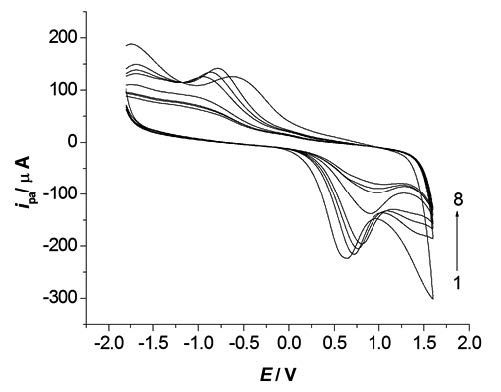STUDY OF DNA–DIETHYLSTILBOESTROL INTERACTION USING GRAPHENE-BASED THIN-FILM SENSOR AND UV–VIS SPECTROSCOPY
- diethylstilboestrol,
- DNA,
- interaction,
- electrochemical method,
- UV–Vis spectroscopy
Copyright (c) 2018 Journal of the Chilean Chemical Society

This work is licensed under a Creative Commons Attribution-NonCommercial-ShareAlike 4.0 International License.
Abstract
The graphene-modified glassy carbon electrode (Gr/GCE) was fabricated by casting graphene (Gr). Some electrochemical parameters for diethylstilbestrol (DES) detection, such as pH, scan rate, and accumulation time were discussed. The interaction of DES with DNA at a Gr/GCE was studied by electrochemical method and factors influencing the interaction were optimized. Under the optimized conditions, the results revealed that the peak current decreased and the peak potential shifted to the positive side after adding DNA into the solution containing DES. We deduced that the interaction of DES with DNA mainly is intercalation. The interaction of DES with DNA was studied by ultraviolet and visible (UV-Vis) absorption spectroscopy. Also, with the addition of DNA, hyperchromic effect and small red shifts were observed in its UV-VIS spectra upon addition of DNA, results indicated that the DES molecule intercalated into the DNA, and the complex of DES-DNA was formed.

References
- P. White, H. Hunt, J. Clin. Endocrinol. 3, 500, (1943).
- A. L. Herbst, H. Ulfelder, D. C. Poskanzer, The New England Journal of Medicine 284, 878, (1971).
- L. Titus-Ernstoff, E. E.Hatch, R. N. Hoover, J. Palmer, E. R. Greenberg, W. Ricker, R. Kaufman, K. Noller, A. L. Herbst, T. Colton, P. Hartge, Br. J. Cancer. 84, 126, (2001).
- L. Titus-Ernstoff, R. Troisi, E. E. Hatch, J. R. Palmer, L. A. Wise, W. Ricker, M. Hyer, R. Kaufman, K. Noller, W. Strohsnitter, A. L.Herbst, P. Hartge, R. N. Hoover, Br. J. Cancer., 95,107, (2006).
- J. B. Quintana, J.Carpinteiro, I. Rodríguez, R. A. Lorenzo, A. M. Carro, R. Cela, J. Chromatogr. A 1024, 177, (2004).
- A. Prieto, A. Vallejo, O. Zuloaga, A. Paschke, B. Sellergen, E. Schillinger, S. Schrader, M. Moder, Anal. Chim. Acta 703, 41, (2011).
- K. Sanfilippo, B. Pinto, M. P. Colombini, U. Bartolucci, D. Reali, J. Chromatogr. B 878,1190, (2010).
- X.P He, X.Q Mei , J.T Wang , , Z.L, L.J Tan , W. Wu, Mar. Pollut. Bull. 102, 142–147, (2016).
- Q. Xu, M. Wang, S. Q. Yu, Q. Tao, M. Tang, Analyst 136,5030, (2011).
- S. Rodriguez-Mozaz, M. J. Lopez de Alda, D. Barcelo, Anal. Chem. 76, 6998, (2004).
- X. B. Chen, Y. L. Wu, T. Yang, J. Chromatogr. B, 879,799, (2011).
- K. Mitani, M. Fujioka, H. Kataoka, J. Chromatogr. A 1081, 218, (2005).
- S. Liu, Q. Lin, X. M. Zhang, X. R. He, X. R. Xing, W. J. Lian, J. Li, M. Cui, J. D. Huang, Sens. Actuators B, 166/167, 562, (2012).
- Q. L. Zhang, J. Li, T. T Ma, Z. T. Zhang, Food Chem.111, 498, (2008).
- J. J. Fei, X. Q. Wen, L. H. Yi, F. Ge, Y. Zhang, M. H. Huang, X. M.Chen, J. Appl. Electrochem. 38, 1527, (2008).
- C. M. Yu, W. Y. Ji, Y. D. Wang, N. Bao, H. Y. Gu, Nanotechnology 241, 15502, (2013).
- K. M. Qu, X. Z. Zhang, Z. L. Lv, M. Li, Z. G. Cui, Y. Zhang, B. J. Chen, S. S. Ma, Q. Kong, Int. J. Electrochem. Sci. 7, 1827, (2012).
- X. Y. Ma, M. F.Chen, Sens. Actuators B 215, 445, (2015).
- L.T Hu, Q. Cheng, D.C. Chen , M. Ma , K.B. Wu, J. Hazard. Mater. 283,157–163, (2015).
- X. L. Wang, J. J. Li, T. Wang, Z. Y. Yu, Ionics 21,1105, (2015).
- F. Li, J. Q. Li, Y. Feng, L. M. Yang, Z. F. Du, Sensor Actuat. B-Chem. 157, 110, (2011).
- Y. R. Kim, S. Bong, Y. J. Kang, Y. Yang, R. K. Mahajan, J. S. Kim, H. Kim, Biosens. Bioelectron. 25, 2366, (2010).
- M. F. Chen, X. Y. Ma, X. Li, J. Solid State Electrochem.16, 3261, (2012).
- X.Y. Ma, M. Y. Chao, M. F. Chen, Russ. J. Electrochem. 50, 154, (2014).
- B. X. Ye, C. H. Wang, A. H. Jing, J. Chin. Chem. Soc. 50, 457, (2003).
- M. T. Carter, M. Rodriguez, A. J. Bard, J. Am. Chem. Soc.111, 8901, (1989).
- L. Fotouhi, A.B. Hashkavayi, and M.M. Heravi, Int. J. Bio.l Macromo. 53,101, (2013).
- M. Aslanoglu, Anal, Sci. 22, 439, (2006).
- C. V. Kumar, E. H. Asuncion, J. Am. Chem. Soc. 115, 8541, (1993).
- A. M. Nowicka, E. Zabost, M. Donten, Z. Mazerska, Z. Stojek, Bioelectrochemistry, 70, 440, (2007).
- Y. N. Ni, M. Wei, S. Kokot, Int. J. Biol.Macromol. 49, 622, (2011).


